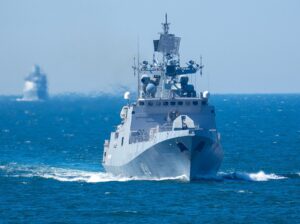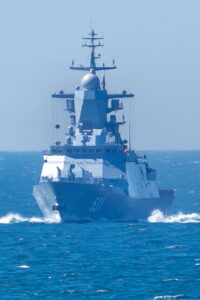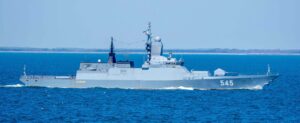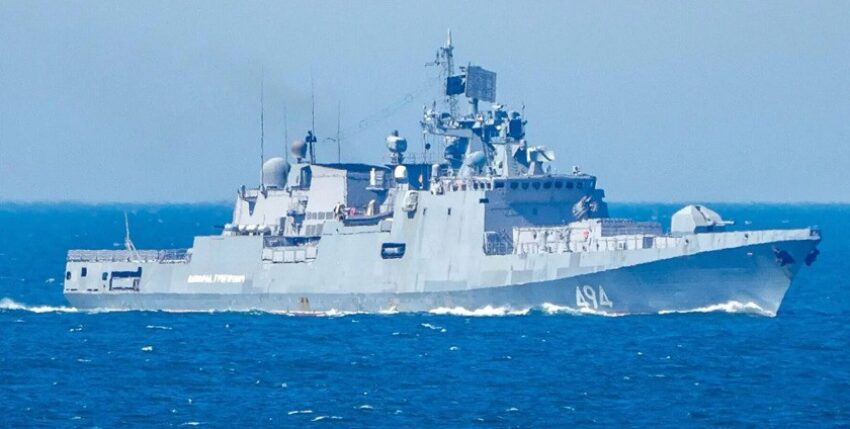For a good two weeks now, NATO navies have been accompanying a Russian formation on its way from the Mediterranean around Western Europe to the harbours and shipyards of the Baltic Fleet. The small group is led by the frigate "Admiral Grigorovich" (494), the type ship of the three combat units built for the Black Sea Fleet - intended as an escort for the cruiser "Slava" and now itself in flagship duty ("Admiral Makarov").

She is followed by two corvettes of the Steregushchiy class (105 metres, 2,200 tonnes), "Stoikiy" (545) and "Soobrazitelniy" (532), which originally belong in the Baltic Sea and have already been mentioned in connection with the acts of sabotage on the Nord Stream pipelines. However, these two were seen entering the Mediterranean near Gibraltar in mid-October and have now been deployed for more than six months. The faithful support tanker "Kama" (116 metres, 9,000 tonnes) was also on board, having accompanied the "Admiral Gorshkov" (type ship, 125 metres, 4,000 tonnes) to South Africa and back via Iran to Tartus in Syria. However, "Kama" now turned back towards the Mediterranean after a final fuel supply at the British Isles in order to ensure supplies at sea.

Repair of "Admiral Grigorovich"
The frigate "Admiral Grigorovich" (together with a Kilo-class submarine) had been transferred from the Black Sea to the Mediterranean before the outbreak of war to reinforce the larger units assembled there from the North and Pacific fleets. The calculation of quickly shifting the focus from a counterweight to NATO forces in the Mediterranean through the Bosporus to complete the Black Sea fleet, if necessary, came to nothing when Turkey closed the Bosporus to all military traffic in accordance with the law after the outbreak of war. Now Tartus is sufficient as a base on the Syrian coast for Russian units for a while, but repairs above a certain size can be ruled out there. So it was probably time for the Grigorovich frigate to dive one or two levels deeper in terms of maintenance and, if necessary, repairs. The facilities of the Baltic Fleet off Kaliningrad and St Petersburg are the closest. The convoy arrived in Baltiysk on 10 May - the headquarters of the Baltic shipyard Yantar (Bernstein), where the "Grigorovich" was laid down a good twelve years ago.

NATO escort
Spanish, Portuguese, British and Irish units observed the transit from close range. The Danish frigates HDMS "Thetis" and HDMS "Peter Willemoes" were entrusted with escorting the convoy for the last few miles into the Baltic Sea from Skagen to Bornholm. Germany used the "Potsdam" of the Federal Police.
What remains in the Mediterranean?
The two heavy submarine tandems consisting of nuclear cruisers (Slava class) and ASW frigates (Udaloy class) of the North and Pacific fleets ("Marshal Ustinov"-"Vitseadmiral Kulakov" and "Varyag"-"Admiral Tributs") were already withdrawn from the Mediterranean theatre of war in November last year and at the beginning of this year. Now only a small remnant remains in the sea area, albeit with hypersonic weapons on the frigate. There are currently five Russian units in the Mediterranean: the frigate "Admiral Gorshkov", the Kilo-class submarine "Krasnodar", the corvette "Orehovo-Zyevo" (Buyan-M class, 74 metres, 950 tonnes), the minesweeper "Vladimir Yemelyanov" (Alexandrite class, 62 metres, 900 tonnes) and the aforementioned tanker "Kama".
Conclusion
Apart from individual missile strikes by submarines from Novorossiysk against Ukrainian infrastructure, the naval forces no longer play a decisive role in the Russian war in Ukraine - and certainly not in the Mediterranean!












7 responses
Can the Admiral Grigorovich cross the rivers back into the Black Sea? Or is it too high for some bridges?
Good question. The waterway from St Petersburg to Rostov-on-Don is navigable via canals, lakes and rivers, but the passenger and cargo ships permitted there tend to be shallow-draft vessels with limited superstructures. In the case of the Project 11356 frigates with their dimensions of 125 metres in length and 15.2 metres in width, however, it is primarily the draught of 4.6 metres and the height of the radar antennas (24.5 m) and mast superstructures of just under 28 metres that make such a passage impossible. Such clearances are certainly not to be found over the entire 5,200 kilometre route - to put it mildly, because the exact nautical limits of this waterway can only be found through intensive research.
To the sentence ...
"The association arrived in Baltiysk on 10 May - the headquarters of the Baltic shipyard Yantar (Bernstein), where the keel of the "Grigorovich" was laid a good twelve years ago."
... it should be noted that the "Yantar" shipyard has its headquarters in Kaliningrad; in Baltiysk there is only the ship repair plant-33 with two floating docks, which is now a subsidiary of the "Yantar" shipyard (which operated as the "Schichau" shipyard until 1945). The repair of the "Admiral Grigorovich" ("Адмирал Григорович") will certainly be carried out at the main plant in Kaliningrad; there are more qualified workers there.
Moin,
Why is the "Slava" class referred to as a "nuclear cruiser" in this report?
This class is powered by gas turbines; the armament is a mix of artillery, missile systems and torpedoes, all of which can be equipped with nuclear warheads, as can any armament of other Russian combat ships...
The tanker "Kama" is also no longer in the Mediterranean; on 11 May 2023, the tanker was ceremoniously welcomed at the main base of the Russian Northern Fleet after completing its last operational voyage (see: https://function.mil.ru/news_page/country/more.htm?id=12467017@egNews).
Are such longer operations by the Russian Navy in international waters currently the rule or the exception? Navy in international waters currently the rule or rather an exception?
Moin,
Longer operations by individual warships or warship detachments have become the rule at present. However, the selection of units capable of doing this is rather limited...
This raises the question: what does the Red Fleet do when it is not deployed against Ukraine?